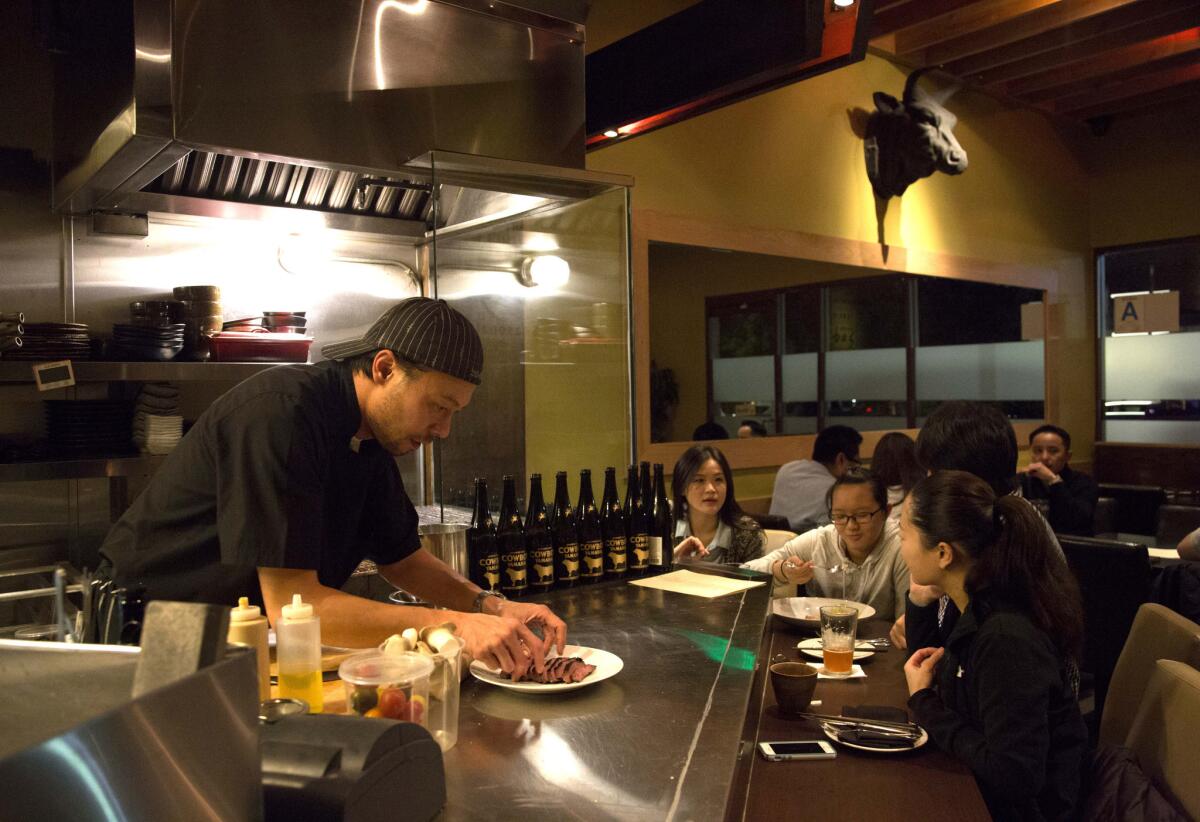Jonathan Gold | L.A. restaurant review: b.o.s. in Little Tokyo goes whole cow

- Share via
Animals, the last few years of American cooking have taught us, have insides and floppy bits as well as the meaty parts that usually make it onto the plate, and it has become impossible to scan the menu of a certain kind of Los Angeles bistro without coming across pig’s ears, oxtails or tripe. If you are going to eat a cow or a chicken, you may as well eat all of a cow or chicken. Nose-to-tail carnivores share with vegans the desire to consume as few animals as possible.
Eating a platter of grilled chicken feet or marrowbones is not just supper; it is dining as a countercultural act. Roast kidneys in mustard sauce or a bowl of braised pig’s feet may just be dinner in Paris or Suzhou, China, as it was to our grandparents wherever they may have lived, but in 2014 Los Angeles, offal is a statement. A food blogger who avoids the grilled heart at Bestia or Picca had better be prepared to explain herself.
While you can find all kinds of fifth-quarter delights at Animal, République and Church & State, the new b.o.s. may be the first dedicated offal restaurant in Los Angeles, a temple of cattle insides where the waiter sighs about the unavailability of lungs, the main decoration on the wall is a mural on which the names of cow organs are arranged in the shape of a cow and the menu features a liver of the day the way that other restaurants do their daily soup. The restaurant’s name may refer to the Latin word for cow, or it may stand for “beef offal sustainable,” as the owner suggests, but there is no mistaking the bovine emphasis.
If you have ever wondered what raw beef tongue might taste like sliced thinly and dressed with a sharp tincture of chile and lime, b.o.s. is the place to discover that it is a bit flavorless. If you’ve contemplated the possibility of substituting beef heart for tuna in a modern tataki dish, you may be pleasantly surprised — the slices of raw organ, slightly smoky where they have been seared over Japanese bincho charcoal, may be chewier than they appear but have basically the same luxurious mouth-feel as the fish and the clean, beefy flavor of rare steak.
The restaurant occupies a space in the Honda Plaza at the east end of Little Tokyo, sharing a parking lot with Sushi Gen, the shabu-shabu den Kagaya and the ramen parlor Men Oh Tokushima. Jun Isogai, who owns Men Oh Tokushima, co-owns the place with David Bartnes, a veteran of hotel restaurants in Asia. Japanese cooking has always been pretty inclusive of innards, as anybody who has scanned the list of skewered chicken intestines, fallopian tubes and gizzards at a yakitori bar can attest, so although the cooking at b.o.s. is not strictly Japanese, its intimate sensibility fits nicely into the neighborhood.
Bartnes wanders over to the table to chat about the high quality of heart he has been able to buy from his current supplier, as well as the super-clean intestines he can sometimes find and the difficulty of sourcing udder. I suspect his dreams may involve muzzles, marrow guts and lampredotto. There are many flavors inside a cow.
Still, although Bartnes’ menu could not be more focused, there is rarely a sense of the extreme, as with the turkey lungs and raw tripe you sometimes find at Chris Cosentino’s Incanto in San Francisco. Nor is there the Rabelaisian excess of places like the tripe specialist Pharamond near Les Halles in Paris, or St. John, the famous London entrepôt of deviled kidneys and rolled spleen.
A child could eat the tacos stuffed with lightly fried sweetbreads without comment (although others of us may privately yearn for funky, crunchy tacos de mollejas from a truck in East L.A.). The tripe “calamari” really do resemble good fried squid, crisp yet elastic, tasting mostly of clean oil. If you didn’t know the provenance of the lightly curried fried calves’ brains, you might think that you were eating fried soft tofu with your puréed squash. The bone marrow may be somewhat overroasted, but the tendon in the risotto is braised to an exquisite softness — there is about three times as much tendon as rice in the dish — and the tripe and kimchi stew tastes like Sunday night Korean home cooking.
Token primal cuts include a giant bone-in short rib glazed with chiles, enough to sate at least two, even without its nest of garlicky braised kale.
The effect is more or less curated cow, less like a joyful wallow than like an intricate procession of tastes almost dainty in the precision of their preparation. With its soft jazz and the intellectual, rather specific menu, b.o.s. could almost be one of those anonymous eight-seat restaurants on a high floor of a Roppongi office building in Tokyo, sparsely populated with customers brought together by their shared love of calves’ brain and Nina Simone.
b.o.s.
This is perhaps the first restaurant in Los Angeles that is dedicated to offal. Among other items, the menu features a liver of the day.
LOCATION
424 E. 2nd St., Los Angeles, (213) 700-7834, bos-la.com
PRICES
Small plates, $10-$18; vegetables, $9; big meat, $28-$36
DETAILS
Open 5:30 to 10 p.m. Tuesdays to Saturdays. Credit cards accepted. Beer and wine. Validated lot parking.
RECOMMENDED DISHES
Grilled miso heart, fried tripe “calamari,” tripe and kimchi stew, braised short rib.
More to Read
Eat your way across L.A.
Get our weekly Tasting Notes newsletter for reviews, news and more.
You may occasionally receive promotional content from the Los Angeles Times.











